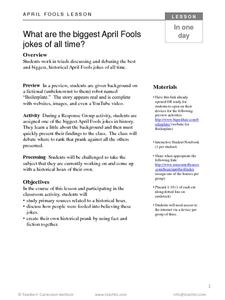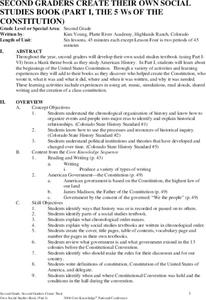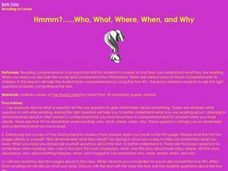Curated OER
Sum It Up !!
Students practice various comprehension strategies to generate the main idea of the text. They encounter unfamiliar concepts and new vocabulary in their quest of the main idea in "Watson's Goes to Burmingham." The Five W's (What, Where,...
Curated OER
Basic Feature Interviewing
Students act as reporters to develop interview skills. In this interview lessons, students develop the skills needed to use anecdotes and quotes to make an interview interesting. They practice asking questions over and above the 5 W's so...
Curated OER
WS 8.9 Presentation Questions
In this mixtures worksheet, students answer twenty three questions about student presentations on topics such as amalgams, homogenized milk, antifreeze and coolants, soaps and detergents and water softeners.
Curated OER
Ws and Worms
Students explore problem solving strategies. Given real life problems, students examine the sum of consecutive strings of whole numbers. Students use diagrams and sequencing to solve problems. Students justify their mathematical...
Curated OER
Build Mastery: Main Idea
Use a graphic organizer to get readers thinking about main ideas as they record the who, what, where, when, and why of a story. Consider modeling this process completely before kids do this independently. They fill in five boxes charting...
Curated OER
Picture This
A unique writing lesson, this plan begins with learners talking about multiculturalism in small groups. Each learner will choose a picture from a newspaper, describe it to their small group, and think about how it relates to...
Oxford University Press
Language Focus: Interrogative and Demonstrative Pronouns
Work on who, what, where, and how with several grammar activities. Additionally, kids complete sentences with demonstrative (relative) pronouns based on whether items are close or far away.
TCI
What Are the Biggest April Fools Jokes of All Time?
After working in groups to analyze primary sources related to a historical hoax, learners will discuss how people managed to be fooled and work to identify one of the biggest April Fools jokes in history.
Bainbridge Class
End of the Year Photo Writing Project
Close out the school year with a look back at a specific event. You provide individuals with photos of themselves, and each pupil fills out the graphic organizer here to prepare for writing a paragraph about the memory depicted in the...
Super Duper Publications
How to Help Your Child Understand and Produce “Wh” Questions
Practice who, what, where, when, and why with a series of activities designed for forming and answering questions. Kids work on choosing the correct wh- word to ask the question they want with a word chart,...
Curated OER
Creating a Newspaper
Get the scoop with a fun, engaging newspaper project. After analyzing the parts of a newspaper, including the headline, subtitles, and pictures or images, young journalists get to work by writing their own stories in a newspaper article...
Curated OER
Not So Personal Pronouns
There are six types of pronouns to explore! Put on your thinking hat and read about each type: demonstrative, indefinite, intensive, interrogative, and reflexive. This worksheet comes with two pages of explanations and examples, and it...
Nosapo
Family Titles, Pronouns, Writing about a Person
How is your grandmother related to you? How is your cousin related to your grandmother? Learn about family relationships and pronouns with an activity that guides pupils to write two short narratives about members of their families.
Curated OER
How can the Internet help us research the information for our news articles?
Fourth graders write a news article. In this news article lesson, 4th graders complete research and answers the five W's about their news topic. Students understand the value of interviewing for a news article. Students...
Curated OER
Second Graders Create Their Own Social Studies Book (Part I, The 5Ws of the Constitution)
Students study the United States Constitution and create a year-long cumulative activity for social studies. In this social studies lesson, students complete activities throughout the year to learn the 5Ws for the United States...
Curated OER
Newsworthy Fairy Tales
Third graders review common fairy tales and work in teams to rewrite the fairy tales as news articles. They answer questions using the 5 Ws (who, what, where, when, why). Student articles include eye-catching headlines.
Curated OER
Riding the Pony Express
Fourth graders list the four W's of the Pony Express. They also write an article about Buffalo Bill Cody and discuss the important facts about the Pony Express.
Curated OER
Summary Selections: Activity Menu for Summarizing and Retelling
In this literacy worksheet, students engage in sixteen activities to summarize and retell what they have read. Activities include flip books for the Five Ws, sequencing, somebody wanted but so..., and literary elements. Activities will...
Curated OER
Traceable Letter W - Preschool Alphabet Page
Young children practice writing the letter w by tracing it using this simple worksheet. This resource includes eight traceable capital w's as well as eight traceable lower case w's for students to complete. Links to the printer-friendly...
Curated OER
Which Practice
In this asking questions instructional activity, 2nd graders read the 'which' questions and draw a line to the correct answer. Students then unscramble the word segments to create 4 'which' questions.
Curated OER
Who, Where, When, What & How
In this question words learning exercise, learners read the phrases and write the correct question word for each phrase. Students complete 8 examples.
Curated OER
Who, Where, When, What & How
In this questions activity, students write 'who, where, when, what, or how' for the underlined word or phrase. Students complete 8 examples.
Curated OER
Hmmm...Who, What, Where, When, and Why
Young scholars practice reading comprehension by answering the 5 "W" questions. After reading "The Kissing Hand," they complete a class discussion addressing the questions who, what, when, where, and why. Students choose an...
Curated OER
Chinese Zodiac
Fifth graders identify the basic elements of a narrative story, such as the beginning, middle, and the end; to analyze the character traits in the story to write a summary using the 5 Ws and How chart included; through sample stories...
Other popular searches
- Five Ws
- 5 W's
- Five W's
- 5 Ws
- 5 W's
- 5 Ws and H
- Reading Comprehension 5 Ws
- 5 Ws of Writing
- Five Ws Graphic Organizer
- 5 W's and How
- The Five Ws
- The Five W's























